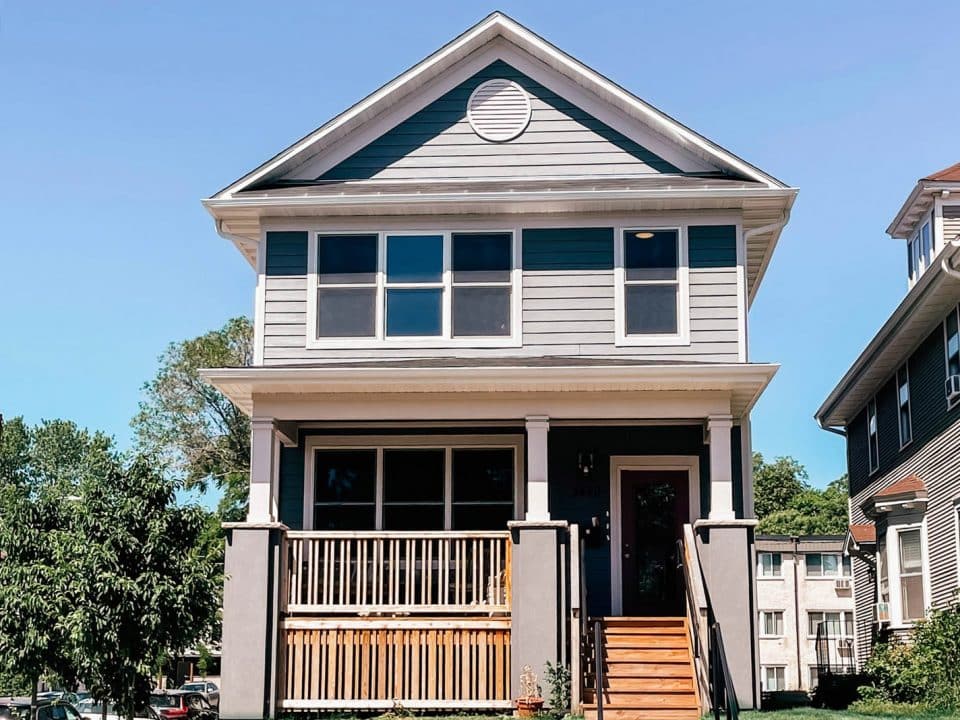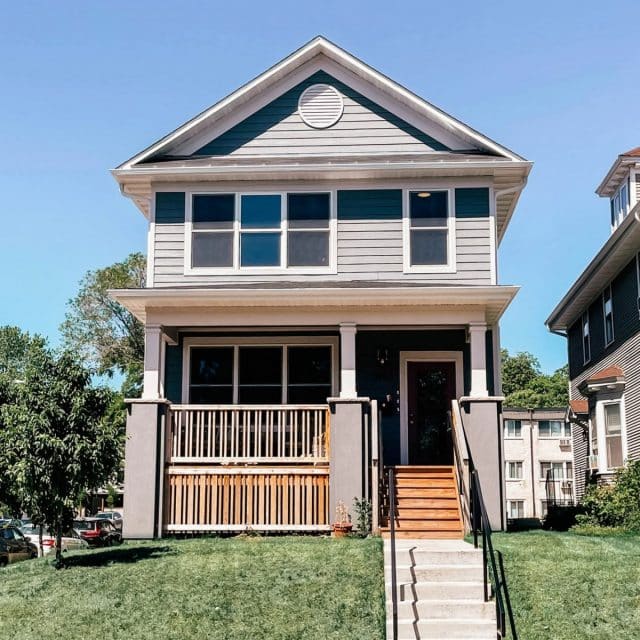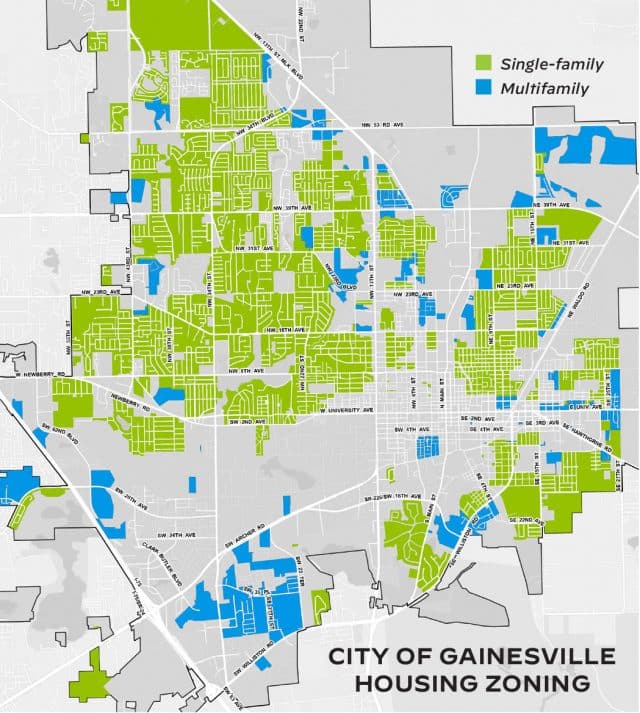
Some Communities Take on Single-Family Zoning in Hopes of Spurring More Housing

Just before midnight on a Thursday in August, Gainesville’s City Commission dismantled a nearly century-old cornerstone of municipal planning efforts: single-family zoning.
A divided commission voted to allow duplexes, triplexes and quadplexes on land that had been set aside exclusively for detached, single-family homes.
This makes Gainesville the first municipality in Florida to vote to eliminate single-family-only zoning districts, and it follows on the heels of a handful of other jurisdictions nationwide — including Minneapolis, Minnesota; Charlotte, North Carolina; Tacoma, Washington; and the states of California and Oregon — that have taken similar actions to loosen residential zoning and update land-use policies with the goal of spurring more affordable housing.
Advocates argue that eliminating single-family zoning can spark more residential building and help address the growing problem of a lack of affordable places for people to live. Opponents cite concerns about gentrification, property values and quality of life.
“I don’t think it’s common enough to be called a trend,” Gainesville land-use planning expert Thomas Hawkins (MSRE ‘10) said. He is an instructional assistant professor in the University of Florida’s Department of Urban and Regional Planning. “I would call it a novelty. That’s a fair word.”
Local politics at play
The case of Gainesville illustrates how residential zoning codes — usually of interest to few but policy wonks — can suddenly become a political minefield and spark pitched battles across the ideological spectrum.
Gainesville Commission members who voted for the measure and their supporters, some of whom are members of a local YIMBY (yes in my backyard) organization, framed the proposal as a strategy to address affordable housing and as way to remedy past economic and racial segregation.
Yet during the six-and-half-hour meeting at a packed city hall, five times as many people spoke against the change than in support of it, the Gainesville Sun reported. Opponents cited a laundry list of reasons they were against the proposal, including lowering property values, displacing poorer residents via gentrification, and creating more noise and parking issues. One commissioner who opposed it said the issue emboldened the city’s Black community like never before.
Supreme Court’s 1926 decision
The battle over single-family zoning is heating up almost a century after a landmark U.S. Supreme Court decision gave municipalities the greenlight to create districts to separate single-family homes from industrial facilities and “nuisances” like multifamily buildings. In ruling that Euclid, Ohio’s 1922 zoning plan did not violate a landowner’s rights, the court declared that “very often the apartment house is a mere parasite” on a residential neighborhood.
Nearly 100 years later, Minneapolis was the first major U.S. city to eliminate zones set aside exclusively for single-family homes with its adoption of a comprehensive plan that went into effect in January 2020. The city said it adopted its Minneapolis 2040 plan after nearly four years of analysis and community engagement with thousands of residents, business owners and others.
The plan, which guides city land use and infrastructure, allows property owners to build two- and three-family houses or expand existing houses to add one or two dwelling units, even in neighborhoods where they were previously prohibited. It also allows for denser development near public transit and commercial corridors, eliminates mandatory parking minimums and permits non-owner-occupied accessory dwelling units.
The question is still out about the impact of the plan. Through June 2022 the city issued permits for 31 duplexes and 17 triplexes in areas where they previously weren’t allowed, according to the Minneapolis Community Planning & Economic Development department.
That may not seem like a lot, but every bit helps, said Bruce Brunner, a Minneapolis residential general contractor whose company has built several of the new units. “There’s no silver bullet in building new housing,” said Brunner, who also serves on the Minneapolis Advisory Committee on Housing.
As expected, the bigger impact of the plan is it “upzoned” transit corridors to allow the building of larger apartment buildings, said Jason Wittenberg, the city’s planning manager. Although Minneapolis has not tracked which of these projects would or wouldn’t have been built, “what we have done is created a higher degree of predictability and certainty in these areas,” he said. The 2040 plan “put in place a regulatory framework that requires far fewer variances to accomplish larger or ‘missing middle’ development projects.”
He added that the plan went into effect as housing construction was impacted by major cost increases, labor shortages and civil unrest. “We are early enough in the implementation of our plan that it is difficult to draw firm conclusions,” he said. “We certainly believe we have made it easier to build many types of housing and to provide more options throughout the city.”
Gainesville city limits

The Gainesville plan would allow small multifamily units in previously single-family zoned neighborhoods, with duplexes permitted on the smallest lots, triplexes on larger-sized lots and quadraplexes on still larger ones. Structures can’t be more than two stories tall. Other provisions would, for example, lessen building setback requirements, reduce the minimum amount of land to build a home and ease the process for splitting properties.
Michael Wolf, a University of Florida law professor whose expertise is land-use planning and local government, said he favored a city commissioner’s proposal to sunset the zoning changes after several years to allow for a study of their effect on home values. “I wish they would do it on an experimental basis. That’s what makes the most sense,” he said. The zoning change “gets a lot of attention. But look how it has backfired with the intended beneficiaries. Many of them have objected to it.”
Hawkins criticized the city’s plan as a “one-size-fits-all” approach hastily developed without the benefit of a thorough community planning process to consider its impact on infrastructure capacity, the environment and neighborhood design.
“These details were never considered as part of the process,” said Hawkins, who as a member of the Plan Board suggested the city adopt changes incrementally and in only select parts of the city. “If it’s going to happen on a broader scale in Florida and nationally, we need to do it thoroughly and consider those kinds of things.”
In the end, it may be much ado about nothing.
In the wake of the new zoning plan, the composition of the city commission is being overhauled. Three of the four commissioners who voted for the plan were term limited, meaning they will be replaced by newly elected members who take office in January, and both remaining candidates for mayor oppose the new zoning plan and advocate repealing it.